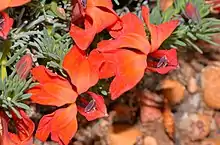Lechenaultia formosa
Lechenaultia formosa, commonly known as the red leschenaultia, is a plant in the family Goodeniaceae native to Western Australia. It was described in 1810 by Robert Brown.[1]
| Lechenaultia formosa | |
|---|---|
 | |
| Lechenaultia formosa in Wandoo National Park | |
| Scientific classification | |
| Kingdom: | Plantae |
| Clade: | Tracheophytes |
| Clade: | Angiosperms |
| Clade: | Eudicots |
| Clade: | Asterids |
| Order: | Asterales |
| Family: | Goodeniaceae |
| Genus: | Lechenaultia |
| Species: | L. formosa |
| Binomial name | |
| Lechenaultia formosa R.Br. | |
David Morrison in his 1986 paper on Lechenaultia selected Lechenaultia formosa to be the lectotype for the genus. It is in the section lechenaultia in the genus. Its closest relatives (according to a cladogram based on morphological features) appear to be L. chlorantha and L. liniaroides.[2] The plant's generic name honors the French botanist Jean-Baptiste Leschenault de La Tour, a pioneer in Australian botany.
Lechenaultia formosa grows as a spreading shrub, anywhere from 20 to 40 centimetres (7.9 to 15.7 in) high.[3]
Lechenaultia formosa is found across a wide swathe of Western Australia, from the Geraldton sandplains south through to the southwestern corner of the state and east along the southern coast. It grows on granite-, laterite- or clay soils, where it is found on hills, and in flat areas and gullies.[3]
Renowned for its bright red, orange or yellow flowers, Lechenaultia formosa is widely cultivated in Australian gardens.[4] It was first grown in the United Kingdom in 1824. Many cultivars were sold in the 1960s that are no longer available. It grows best in well-ventilated locations with very good drainage; otherwise it is prone to fungal disease, in particular grey mould (Botrytis cinerea) of the branches and soil-borne Phytophthora and Pythium, and is often short-lived.[4] It is propagated readily from cuttings of semi-hardened wood.[5] Plants grown this way can be used to replace older plants when they die.
Lechenaultia formosa can be grown in hanging baskets or rockeries.[6]
References
- "Lechenaultia formosa R.Br". Australian Plant Name Index (APNI), IBIS database. Centre for Plant Biodiversity Research, Australian Government.
- Morrison, David A. (1986). "Taxonomic and nomenclatural notes on Lechenaultia R.Br. (Goodeniaceae)" (PDF). Brunonia. 9 (1): 1–28. doi:10.1071/bru9860001.
- "Lechenaultia formosa R.Br". the Western Australian Flora. FloraBase, Western Australian Herbarium. Retrieved 4 January 2015.
- Elliot, Rodger W.; Jones, David L.; Blake, Trevor (1993). Encyclopaedia of Australian Plants Suitable for Cultivation:Volume 6 - K–M. Port Melbourne, Victoria: Lothian Press. p. 70. ISBN 0-85091-589-9.
- Zhang, Sue Shuyin (21 July 2013). "Lechenaultia formosa". Growing Native Plants. Australian National Botanic Gardens. Retrieved 4 January 2015.
- Walters, Brian (November 2007). "Lechenaultia formosa". Plant Guides. Australian Native Plants Society (Australia). Retrieved 4 January 2015.
External links
 Media related to Lechenaultia formosa at Wikimedia Commons
Media related to Lechenaultia formosa at Wikimedia Commons- Lechenaultia formosa occurrence data from Australasian Virtual Herbarium